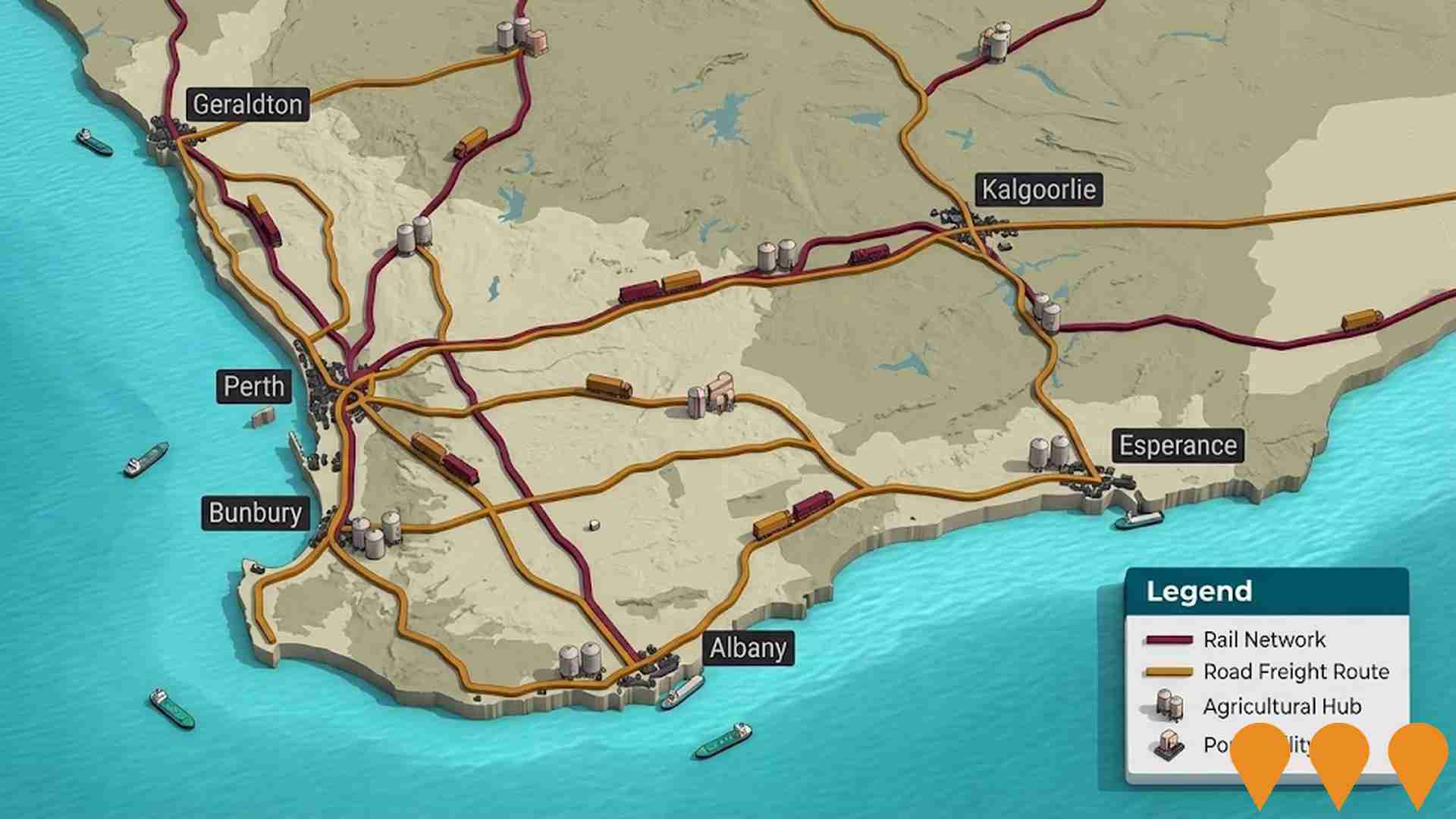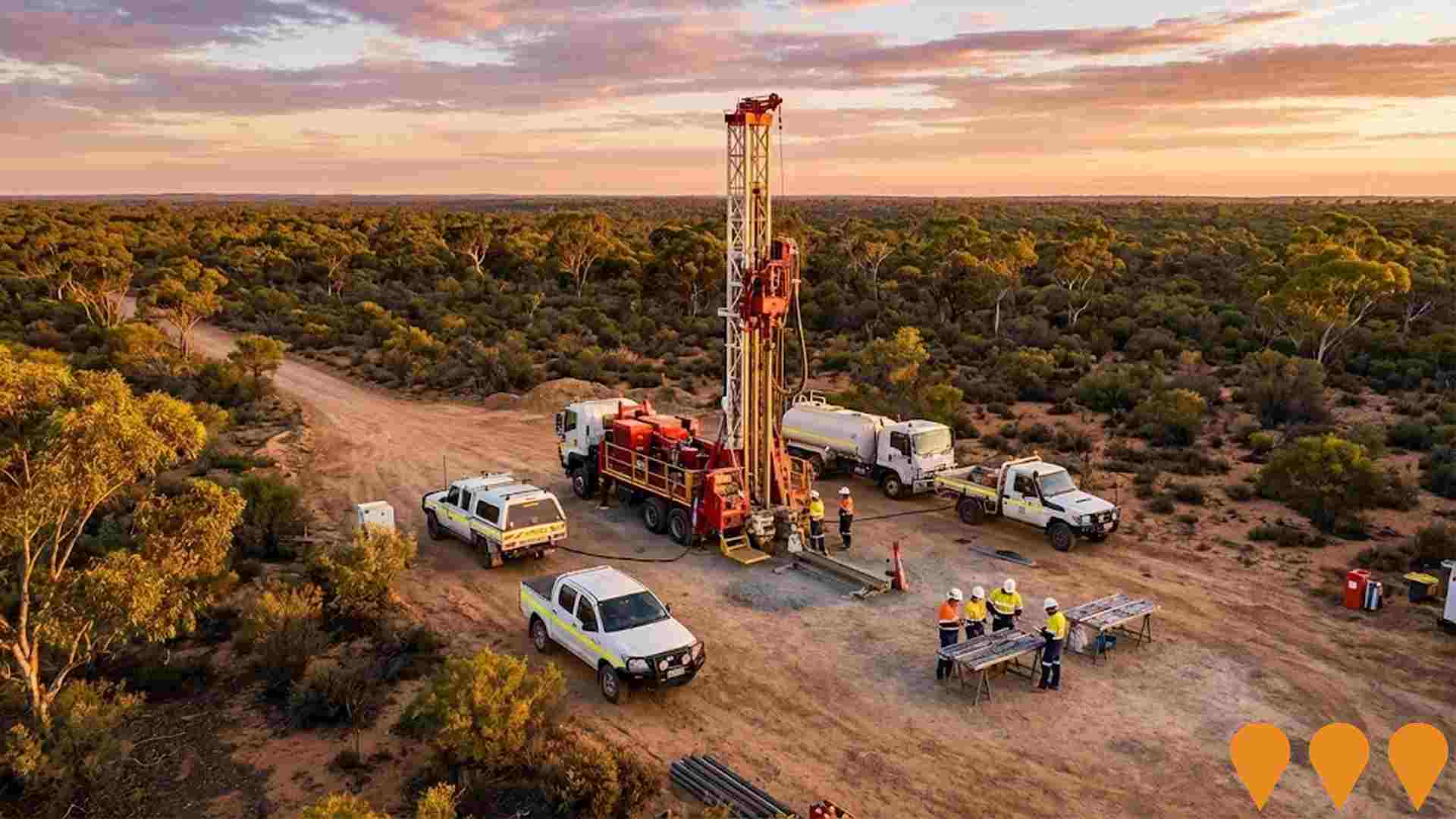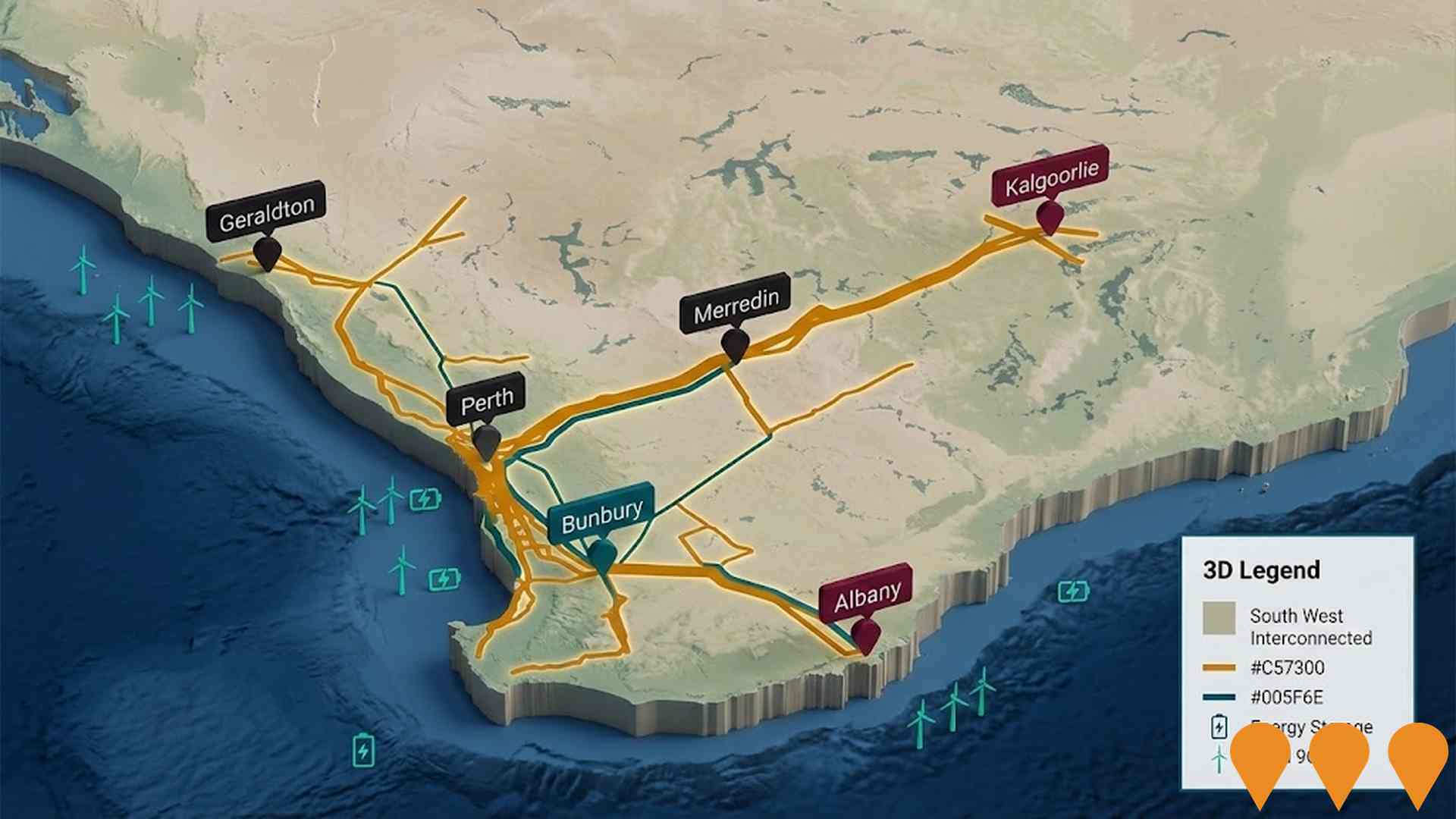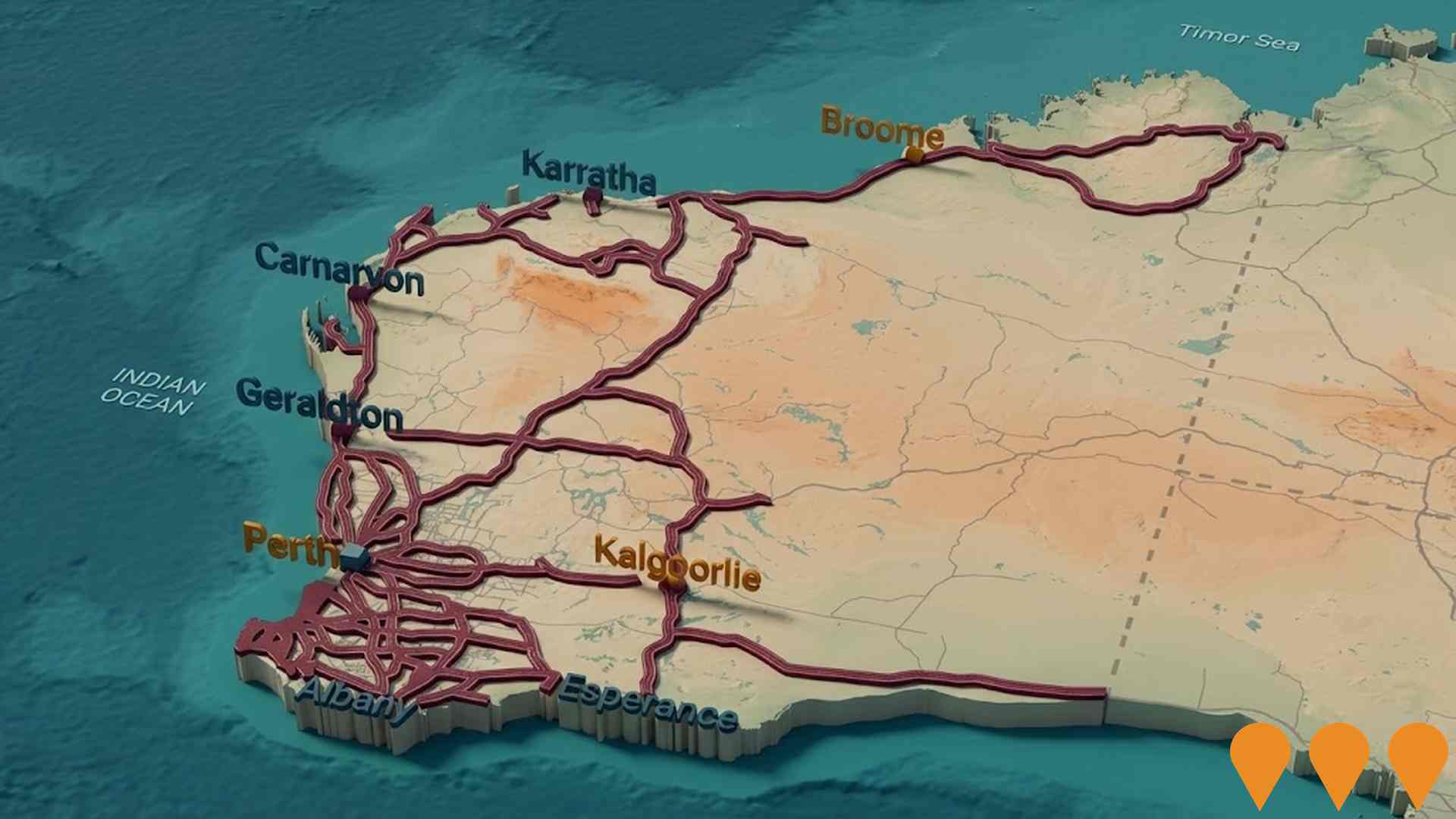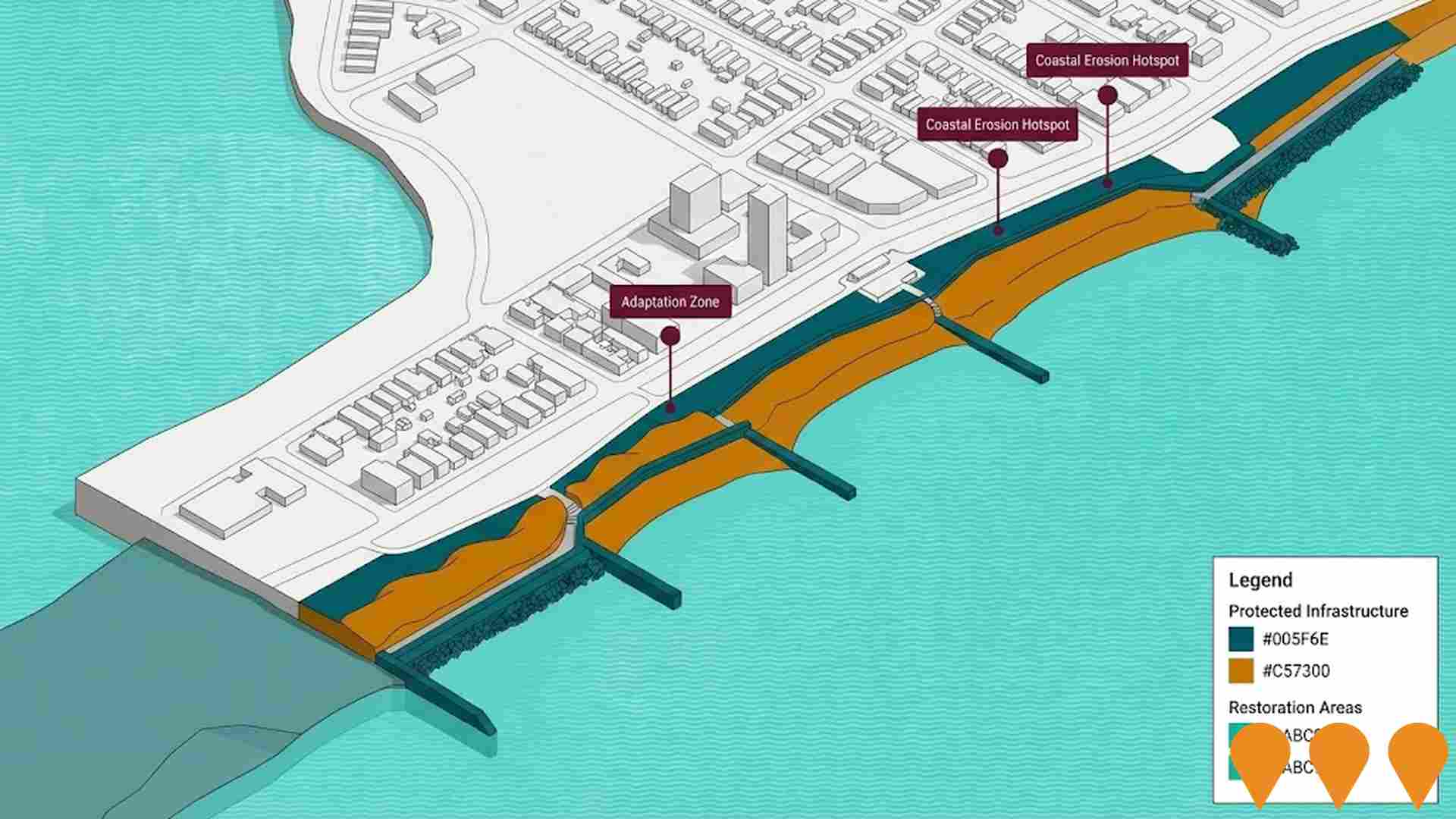Chart Color Schemes
est. as @ -- *
ABS ERP | -- people | --
2021 Census | -- people
Sales Activity
Curious about local property values? Filter the chart to assess the volume and appreciation (including resales) trends and regional comparisons, or scroll to the map below view this information at an individual property level.
Find a Recent Sale
Sales Detail
Population
Mukinbudin has shown very soft population growth performance across periods assessed by AreaSearch
Mukinbudin's population, as of Aug 2025, is approximately 3,087. This figure represents an increase of 82 people since the 2021 Census, which recorded a population of 3,005. The change is inferred from ABS data showing an estimated resident population of 3,091 as of June 2024 and an additional 8 validated new addresses after the Census date. This results in a population density ratio of 0.10 persons per square kilometer. Overseas migration contributed approximately 73.8% to recent population gains.
AreaSearch uses ABS/Geoscience Australia projections for each SA2 area, released in 2024 with a base year of 2022. For areas not covered by this data and post-2032 estimations, AreaSearch utilises growth rates by age cohort from the ABS's Greater Capital Region projections, released in 2023 based on 2022 data. Based on projected demographic shifts, a population increase of just below the median for regional areas nationally is expected by 2041. The area is projected to expand by 173 persons by this year, reflecting an overall increase of approximately 5.7%.
Frequently Asked Questions - Population
Development
AreaSearch assessment of residential development drivers sees a low level of activity in Mukinbudin, placing the area among the bottom 25% of areas assessed nationally
Mukinbudin averaged approximately five new dwelling approvals annually between FY21-FY25, with a total of 25 homes approved during this period. No new dwellings have been approved in FY26 to date. The population has declined recently, suggesting that new supply has met demand, providing good options for buyers.
New properties are constructed at an average expected cost of $303,000, which is below regional levels, indicating more affordable housing choices. In FY26, $2.9 million in commercial development approvals have been recorded, reflecting the area's residential character. Compared to Rest of WA, Mukinbudin has significantly lower construction activity, with 73.0% fewer approvals per person, suggesting stronger demand and values for established dwellings. However, construction activity has increased recently. This activity remains below the national average, indicating the area's established nature and potential planning limitations.
All recent building activity involves detached dwellings, maintaining Mukinbudin's traditional low-density character with a focus on family homes. The estimated population per dwelling approval is 360 people, reflecting its quiet development environment. Future projections indicate that Mukinbudin will add 177 residents by 2041. Development is keeping pace with projected growth, but buyers may face increasing competition as the population expands.
Frequently Asked Questions - Development
Infrastructure
Mukinbudin has emerging levels of nearby infrastructure activity, ranking in the 35thth percentile nationally
Changes to local infrastructure significantly impact an area's performance. AreaSearch has identified five projects likely affecting this region. Notable projects are Great Eastern Highway Upgrades, Walgoolan to Southern Cross, Moon Village, King Rocks Wind Farm, and Western Australia Agricultural Supply Chain Improvements. Relevant details for these projects follow.
Professional plan users can use the search below to filter and access additional projects.
INFRASTRUCTURE SEARCH
 Denotes AI-based impression for illustrative purposes only, not to be taken as definitive under any circumstances. Please follow links and conduct other investigations from the project's source for actual imagery. Developers and project owners wishing us to use original imagery please Contact Us and we will do so.
Denotes AI-based impression for illustrative purposes only, not to be taken as definitive under any circumstances. Please follow links and conduct other investigations from the project's source for actual imagery. Developers and project owners wishing us to use original imagery please Contact Us and we will do so.
Frequently Asked Questions - Infrastructure
Resources Community Investment Initiative
A $750 million partnership between the Western Australian Government and seven major resource companies (Rio Tinto, BHP, Woodside Energy, Chevron Australia, Mineral Resources, Fortescue, Roy Hill) to co-fund community, social and regional infrastructure projects across regional Western Australia, with strong focus on the Pilbara, Goldfields, Kimberley, Mid West and Gascoyne.
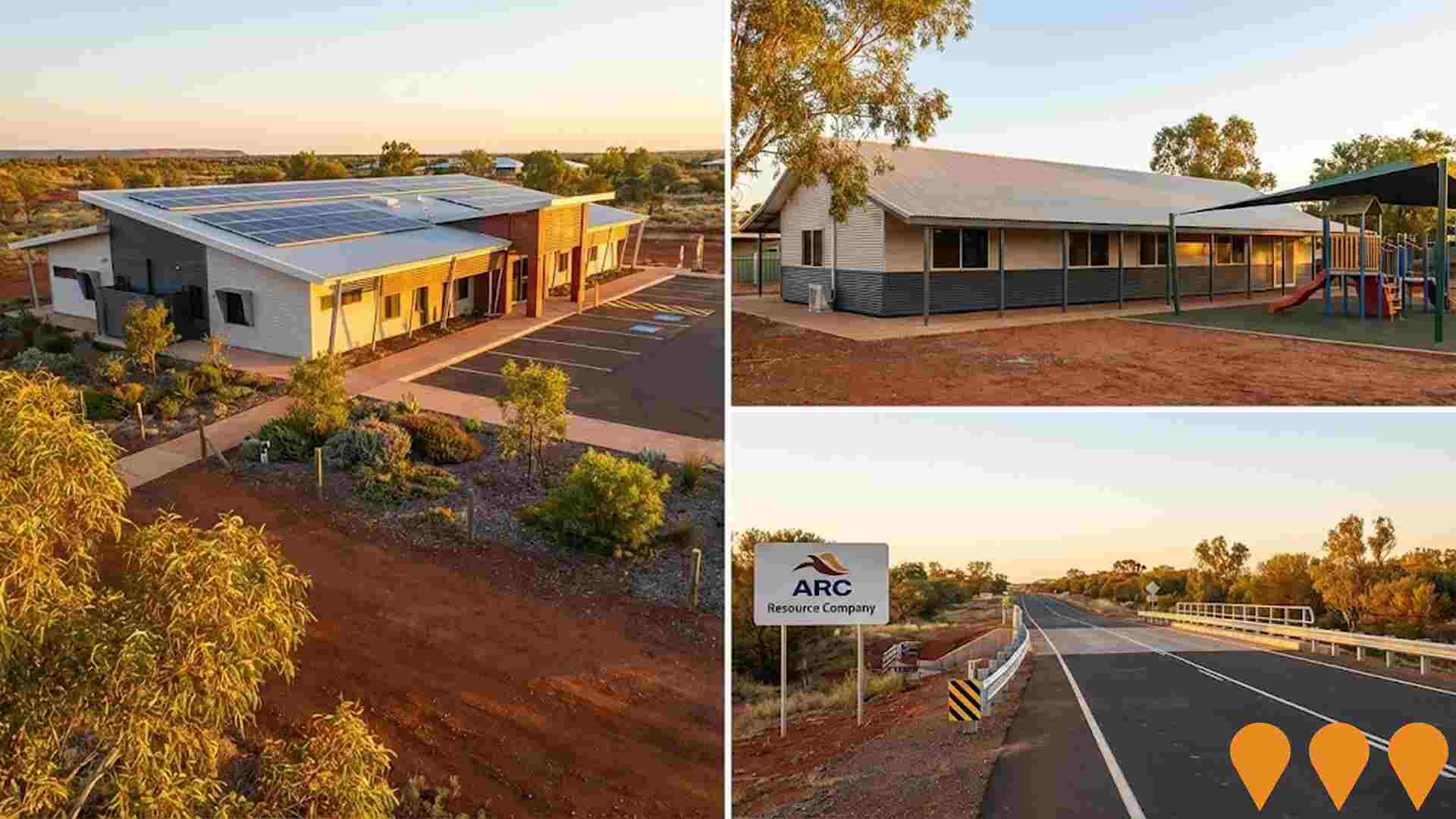
National EV Charging Network (Highway Fast Charging)
Partnership between the Australian Government and NRMA to deliver a backbone EV fast charging network on national highways. Program funds and co-funds 117 DC fast charging sites at roughly 150 km intervals to connect all capital cities and regional routes, reducing range anxiety and supporting EV uptake.

Bulk Water Supply Security
Nationwide program led by the National Water Grid Authority to improve bulk water security and reliability for non-potable and productive uses. Activities include strategic planning, science and business cases, and funding of state and territory projects such as storages, pipelines, dam upgrades, recycled water and efficiency upgrades to build drought resilience and support regional communities, industry and the environment.

WA Regional Digital Connectivity Program (WARDCP)
Statewide co-investment program delivering new and upgraded mobile, fixed wireless and broadband infrastructure to improve reliability, coverage and performance for regional and remote Western Australia. Current workstreams include the Regional Telecommunications Project, State Agriculture Telecommunications Infrastructure Fund, and the WA Regional Digital Connectivity Program (WARDCP).

Network Optimisation Program - Roads
A national program concept focused on improving congestion and reliability on urban road networks by using low-cost operational measures and technology (e.g., signal timing, intersection treatments, incident management) to optimise existing capacity across major city corridors.

Great Eastern Highway Upgrades, Walgoolan to Southern Cross
Staged upgrades of Great Eastern Highway between Walgoolan and Southern Cross form part of the wider Coates Gully and Walgoolan to Coolgardie program, delivering bridge replacements, road widening and sealing, new overtaking lanes, townsite improvements and safety upgrades to improve freight efficiency and reliability on the key Perth to Kalgoorlie corridor.
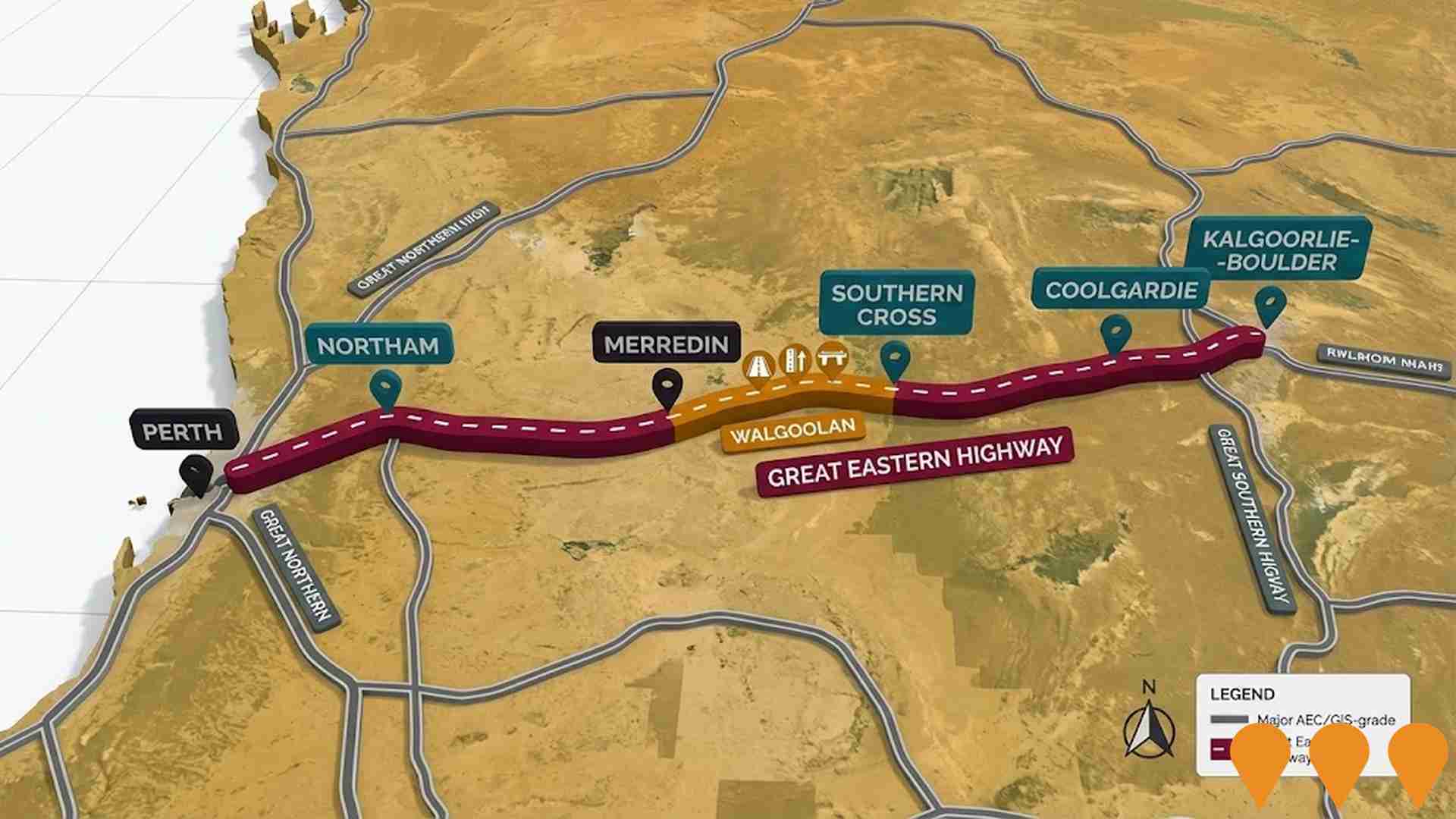
Moon Village
A sustainable human habitat on the Moon, featuring workspaces, living quarters, and support systems.
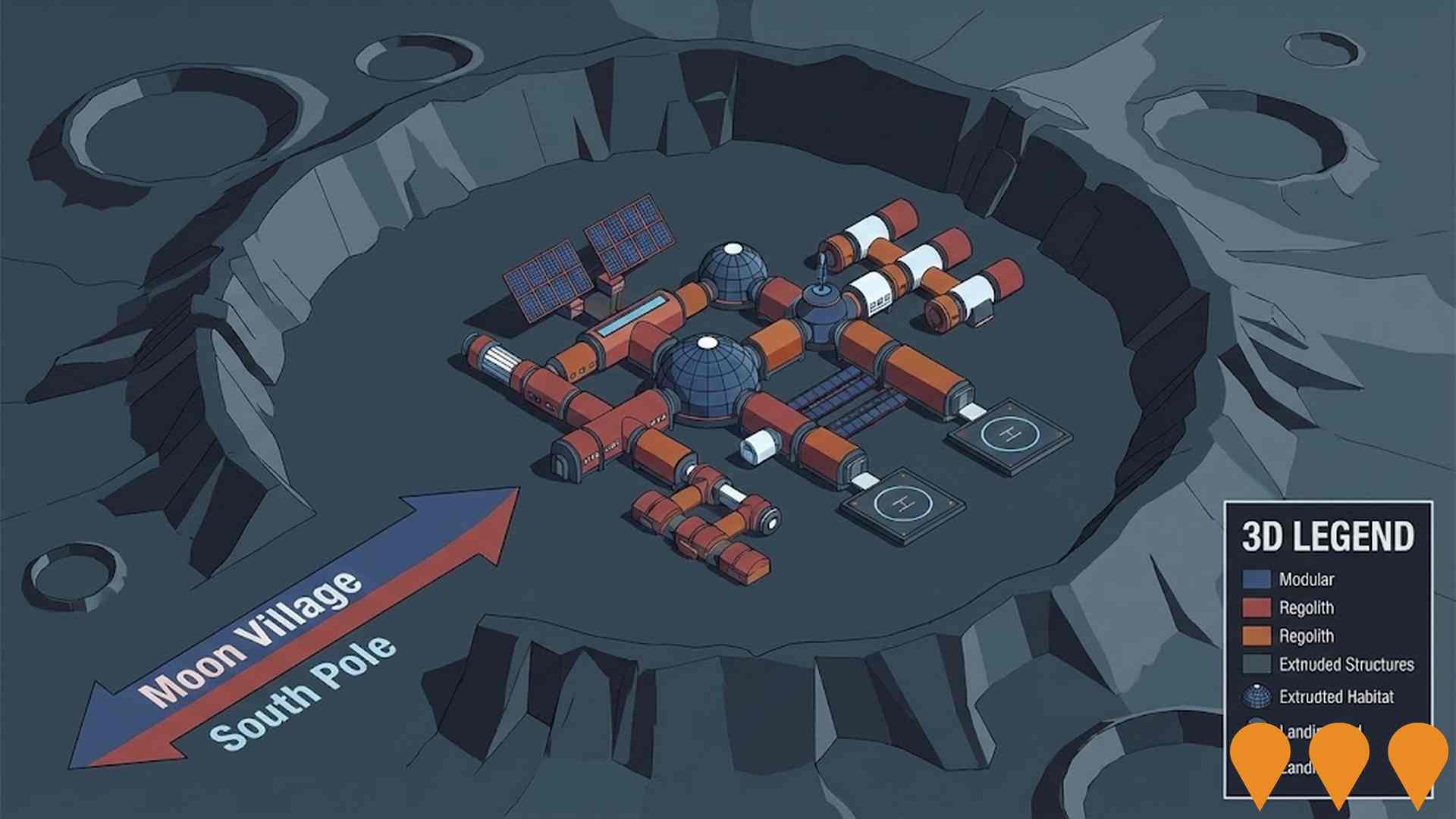
King Rocks Wind Farm
A 105 megawatt wind farm with 17 turbines, expected to power up to 70,000 homes. The project is a key part of Western Australia's energy transition and is located on predominantly cleared, freehold agricultural land with a strong wind resource. The project includes construction of associated infrastructure such as roads, transmission lines, and substation facilities.
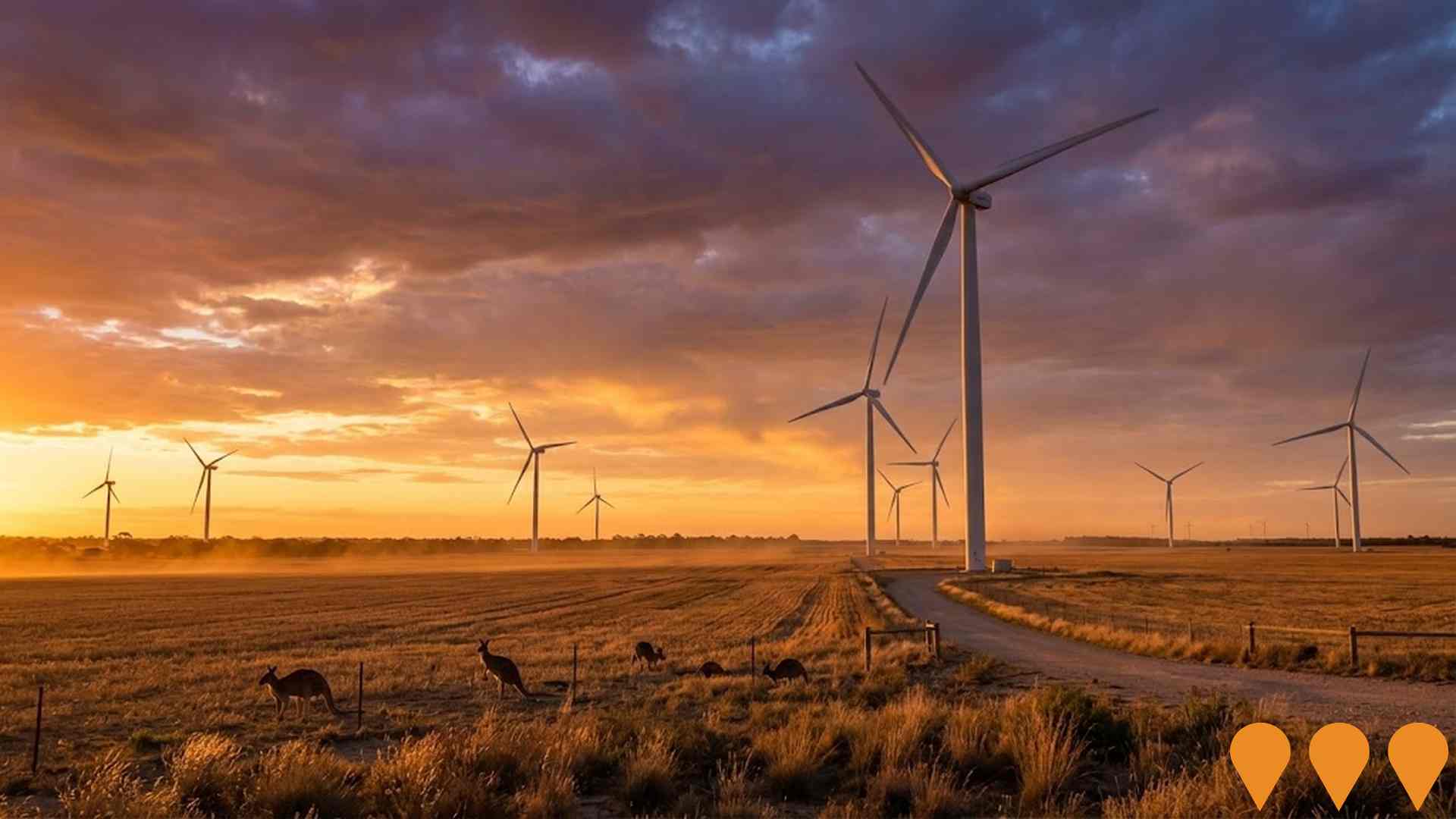
Employment
Employment conditions in Mukinbudin demonstrate exceptional strength compared to most Australian markets
Mukinbudin has a diverse workforce with both white and blue collar jobs, particularly in manufacturing and industrial sectors. Its unemployment rate was 1.6% as of June 2025, lower than the Rest of WA's rate of 3.2%.
There were 1,885 employed residents at this time. The key industries are agriculture, forestry & fishing, mining, and public administration & safety. Agriculture, forestry & fishing has a notable concentration with employment levels at 3.9 times the regional average. Health care & social assistance has limited presence with 6.2% employment compared to 11.9% regionally.
The worker-to-resident ratio is 0.7, indicating above-average local employment opportunities. Over the year to June 2025, labour force levels decreased by 1.8%, and employment decreased by 0.4%. This resulted in a 1.5 percentage point fall in unemployment rate. In comparison, Rest of WA had employment growth of 1.1% and labour force growth of 0.5%, with unemployment falling by 0.6 percentage points. National employment forecasts from Jobs and Skills Australia (May 2025) project a 6.6% increase over five years and 13.7% over ten years. Applying these projections to Mukinbudin's industry mix suggests local growth of approximately 4.2% over five years and 10.1% over ten years, though this is a simplified extrapolation for illustrative purposes only.
Frequently Asked Questions - Employment
Income
Income levels align closely with national averages, indicating typical economic conditions for Australian communities according to AreaSearch analysis
AreaSearch's latest postcode level ATO data for financial year 2022 shows Mukinbudin's median income among taxpayers is $58,570. The average income is $71,248. Nationally, the median income is lower at $56,391 and the average is $80,864. In Rest of WA, the median income is $57,323 with an average of $71,163. Based on Wage Price Index growth of 14.2% since financial year 2022, current estimates for Mukinbudin would be approximately $66,887 (median) and $81,365 (average) as of September 2025. According to the 2021 Census, household incomes in Mukinbudin are at the 19th percentile while personal income is at the 60th percentile. The income bracket of $1,500 - 2,999 dominates with 28.5% of residents (879 people), similar to the metropolitan region where this cohort represents 31.1%. Housing costs are manageable with 94.9% retained, but disposable income is below average at the 33rd percentile.
Frequently Asked Questions - Income
Housing
Mukinbudin is characterized by a predominantly suburban housing profile, with above-average rates of outright home ownership
Mukinbudin's dwellings, as per the latest Census, were 95.9% houses and 4.0% other dwellings (semi-detached, apartments, 'other' dwellings), compared to Non-Metro WA's 95.6% houses and 4.4% other dwellings. Home ownership in Mukinbudin was 55.3%, with mortgaged dwellings at 18.3% and rented at 26.4%. The median monthly mortgage repayment was $719, below Non-Metro WA's average of $1,425. Median weekly rent in Mukinbudin was $133, compared to Non-Metro WA's $231. Nationally, Mukinbudin's mortgage repayments were significantly lower than the Australian average of $1,863, and rents substantially below the national figure of $375.
Frequently Asked Questions - Housing
Household Composition
Mukinbudin features high concentrations of lone person households, with a lower-than-average median household size
Family households constitute 61.5% of all households, consisting of 21.0% couples with children, 33.7% couples without children, and 6.3% single parent families. Non-family households make up the remaining 38.5%, with lone person households at 36.7% and group households comprising 1.7% of the total. The median household size is 2.1 people, which is smaller than the Rest of WA average of 2.3.
Frequently Asked Questions - Households
Local Schools & Education
Mukinbudin faces educational challenges, with performance metrics placing it in the bottom quartile of areas assessed nationally
The area's university qualification rate is 12.6%, significantly lower than the Australian average of 30.4%. Bachelor degrees are the most common at 10.1%, followed by graduate diplomas (1.6%) and postgraduate qualifications (0.9%). Vocational credentials are prevalent, with 38.7% of residents aged 15+ holding them, including advanced diplomas (8.5%) and certificates (30.2%). Educational participation is high at 26.7%, comprising 13.1% in primary education, 6.6% in secondary education, and 2.0% in tertiary education.
Mukinbudin has a network of 8 schools educating approximately 286 students, including 6 primary and 2 K-12 schools. School places per 100 residents (9.3) are below the regional average (12.2), with some students potentially attending schools in nearby areas.
Frequently Asked Questions - Education
Schools Detail
Nearby Services & Amenities
Transport
Transport servicing is low compared to other areas nationally based on assessment of service frequency, route connectivity and accessibility
Mukinbudin has ten active public transport stops, all of which are bus stops. These stops are served by one route in total, offering nine weekly passenger trips combined. Transport accessibility is rated as limited, with residents typically located 37736 meters from the nearest stop.
The average service frequency across all routes is one trip per day, equating to approximately zero weekly trips per individual stop.
Frequently Asked Questions - Transport
Transport Stops Detail
Health
Health performance in Mukinbudin is lower than average with common health conditions somewhat prevalent across both younger and older age cohorts
Mukinbudin faces significant health challenges with common health conditions prevalent across both younger and older age cohorts. Approximately 55% (~1,697 people) of its total population has private health cover, compared to 52.8% across the rest of WA.
The most common medical conditions in the area are arthritis (affecting 9.1% of residents) and asthma (7.9%). Sixty-six point four percent of residents declared themselves completely clear of medical ailments, compared to 64.7% across the rest of WA. Twenty point seven percent of residents are aged 65 and over (639 people). Health outcomes among seniors in Mukinbudin are above average, performing better than the general population in health metrics.
Frequently Asked Questions - Health
Cultural Diversity
Mukinbudin ranks below the Australian average when compared to other local markets across a number of language and cultural background related metrics
Mukinbudin, as per the census conducted on Tuesday 10 June 2008, exhibited lower cultural diversity compared to regional averages. The population was predominantly Australian citizens, with 79.8%, born in Australia, at 84.2%, and speaking English only at home, at 95.0%. Christianity was the dominant religion, practiced by 53.8% of Mukinbudin's population, compared to 49.0% across the Rest of WA.
The top three ancestry groups were English (33.5%), Australian (31.3%), and Scottish (8.0%). Notable differences in ethnic group representation included South African at 0.7%, Welsh at 0.7%, and New Zealand at 0.9%, each higher than regional averages of 0.5%, 0.6%, and 0.8% respectively.
Frequently Asked Questions - Diversity
Age
Mukinbudin hosts an older demographic, ranking in the top quartile nationwide
Mukinbudin has a median age of 46, which is higher than the Rest of WA figure of 40 and also above the national average of 38. The age profile shows that those aged 55-64 are particularly prominent at 16.5%, while those aged 15-24 are smaller at 6.6%. This concentration of 55-64 year-olds is higher than the national figure of 11.2%. Between the 2021 Census and now, the age group of 35 to 44 has grown from 11.8% to 13.2%, while the 55 to 64 cohort has declined from 18.1% to 16.5%. By 2041, demographic projections show significant shifts in Mukinbudin's age structure. Notably, the 25 to 34 group is projected to grow by 31%, reaching 513 from 392. Conversely, population declines are projected for those aged 5-14 and 85+.
